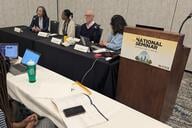You have /5 articles left.
Sign up for a free account or log in.
As colleges and universities continue to add chief diversity officers to their top administrative ranks, some from within and outside the profession have called for a set of professional standards to guide their work. What qualifications should these officers have? What exactly do their jobs entail? How do they relate to equal opportunity officers on campus? The National Association of Diversity Officers in Higher Education has responded to their concerns by today releasing a list of Standards of Professional Practice for Chief Diversity Officers.
“These standards are useful as guideposts to help clarify and specify the scope and flexibility of the work of [chief diversity officers], and provide a set of guidelines to inform and assist individual administrators and institutions in aligning the work of [officers] on their campuses with the evolving characteristics of the profession,” reads the document.
Put another way, the association says, the standards aren’t meant to be a “hiring guide” or a fixed set of rules. Rather, they're a template emphasizing the role of the chief diversity officer as an “organizational change agent for equity, diversity and inclusion,” working within a larger team of administrators and faculty members who share the same goals.
Chief diversity officers’ work is far-reaching, according to the standards, encompassing a “wide range of social identities (e.g., race, gender, sexual orientation), focal groups (e.g., students, faculty and staff), and core areas applicable across focal groups and social identities (e.g., recruitment and retention, campus climate, curriculum and instruction).”
The chief diversity officer position has evolved “to fill a senior leadership role that was not fully represented by earlier administrative posts with titles ranging from ‘minority affairs’ […] to ‘affirmative action officers’," the document says.
Indeed, such officers have traditionally had and continue to have more compliance-based roles, making sure that colleges and universities are acting according to local, state and federal laws related to diversity. Chief diversity officers, on the other hand, tend to take a broader, more proactive approach (although they may still also be responsible for compliance, especially at smaller institutions). That includes anything from working with the faculty on inclusive curriculum to conducting climate surveys to leading staff workshops on promoting diversity.
Experts say it’s necessary for both diversity and equal-opportunity officers to work together, but that conflicts sometimes arise when equal opportunity officers are displaced in the university hierarchy by chief diversity officers, or when chief diversity officers are unfamiliar with the compliance issues underlying their work.
The standards don’t say that chief diversity officers have to have a legal background, but stress the importance of familiarity with the legal underpinnings of the work – along with other historical, managerial and pedagogical knowledge.
A dozen specific guidelines, condensed here, say that a chief diversity officer:
- “Has the ability to envision and conceptualize the diversity mission of an institution through a broad and inclusive definition of diversity,” and clearly communicate it.
- Understands and knows how to navigate the management structure in which he or she is working to effect change.
- Has working knowledge of research suggesting the educational benefits of learning in a diverse and inclusive environment, and how curriculum and institutional programming can be used to advance diversity and inclusion.
- Has basic knowledge of how “various forms of institutional data can be used to benchmark and promote accountability for the diversity mission in higher education institutions,” and how campus climate research can promote a positive, inclusive environment.
- Knows the procedure for responding to reports of bias on campus.
- “Broadly understands” the potential diversity-related barriers that faculty members face in promotion and tenure processes.
- Has current and historical knowledge related to issues of nondiscrimination, access and equity in higher education, and “awareness and understanding” of related laws, regulations and policies.
Benjamin Reese Jr., association president and vice president and chief diversity officers at Duke University, said in a statement that while no document "can reflect the wide range of institutions, organizational structures and varied professional backgrounds of all [chief diversity officers], the ‘Standards’ provide well thought-out and comprehensive guidelines that can assist current (and aspiring) [chief diversity officers] in providing effective institutional leadership."
Reese said he expected the standards -- which were approved by national association's board of directors and are set to expire in 2021 -- to be adapted to fit various institutions' needs.
Various administrators praised the guidelines. Freeman Hrabowski, president of the University of Maryland, Baltimore County, said chief diversity officers’ work on many campuses is “more important than ever,” considering how campus demographics are changing, and that the standards will help “facilitate” officers’ efforts.
Ana Mari Cauce, provost of the University of Washington, called the standards an “important effort” that is the first to “articulate a comprehensive set of standards that will both define and professionalize” the chief diversity’s officer’s role. Until now, she said, such officers have “proliferated across the academic landscape with often at best a vague understanding of their potential, or desired, role and impact.”
Shirley Wilcher, executive director of the American Association for Access Equity and Diversity, has previously criticized some new chief diversity officers for having insufficient legal knowledge of their field -- even if they do have a Ph.D. Via email, she also praised the new standards, saying that while they’re intended for colleges and universities, they’re also “tremendously important in articulating the knowledge and role of the [chief diversity officer] and its essential position in the executive leadership of any organization.”
At the same time, Wilcher called on the chief diversity officers’ association to “build stronger interconnected efforts” with the equal opportunity and other compliance-based officers who make up her associations’ membership “to promote a healthy and respectful environment for the entire academic community.”





